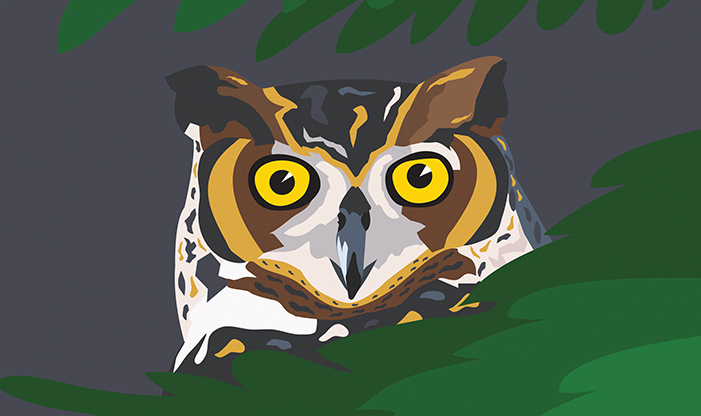In winter, wildlife’s unspoken goal is to outlast. But when other life seems to enter a holding pattern, the Great Horned Owl thrives. A variety of physical and behavioral adaptations allow the Great Horned Owl to be an effective hunter and Wisconsin’s most common year-round raptor resident.
Like most other owls, Great Horned Owls are most active after sundown. Their proportionally large eyes and precise hearing allow them to perch and locate prey under brush or snow. In a swooping flight, a flexible neck allows owls to monitor their meal’s movement until the moment comes for a talons-first dive. After a night of successful hunting, Great Horned Owls will perch for a day of rest, blending into their surroundings to avoid unwanted attention.
These birds’ stealthy dispositions are complemented by dense barring and mottling across their whole body. If you see one in Wisconsin, it will appear tawny. Great Horned Owls are a nationwide bird found in a wide range of habitats: from desert to tundra, evergreen to broadleaf, and wild forest to suburban parks and even your neighborhood.
Hunting Habits of the Great Horned Owl
Their success as a top predator is also related to their size. They are the second largest owl in the state, just smaller than the Snowy Owl, weighing in at 2-3.5 lbs. and boasting up to a four-and-a-half- foot wingspan. Their size affords them opportunities for hunting that a smaller Eastern Screech Owl or Barred Owl doesn’t have. Whatever fits under their talons may be on the dinner plate: small rodents, rabbits, nesting birds, and even animals the size of a skunk! You can often find the signs of a Great Horned Owl’s hunt in winter by wing marks spread across fresh Wisconsin snow.
Breeding and Nesting Patterns
Winter marks the time when Great Horned Owls begin to announce themselves with gusto, though they are generally quiet and avoidant of humans. The male booms a low, stuttering series of hoots that garners a higher-pitched response from a nearby female. Breeding season can begin as early as December for these birds, allowing them to lay, incubate, and hatch chicks without competition from migratory raptors. With enough prey available, mates can nest in surprisingly small woodlots within their two miles of territory. They rarely go farther than one mile from their nest. Once they find a mate, Great Horned Owls will settle in the empty nests of migrant hawks, tree crags, or hollows that they line with pellets and feathers.
Once the Great Horned Owls have laid their one to five eggs, both males and females will incubate them for up to five weeks. As chicks hatch and develop, adults may continue to provide care and protection into July! But they don’t remain sociable for long. When care is no longer needed, parents and offspring form new, tighter territories. Their potential density and ability to use many habitats and diets makes Great Horned Owls common even in suburban green spaces. Roosting near humans can offer an owl a steady supply of rodents, though it also exposes the bird to inherent risk.
The next time you’re hiking on the Center’s trails, look up if you hear their distinctive “hooting” sound, as you will often find Great Horned Owls close by. During the mating season, you might even see them nesting in the hollow of a nearby tree.


